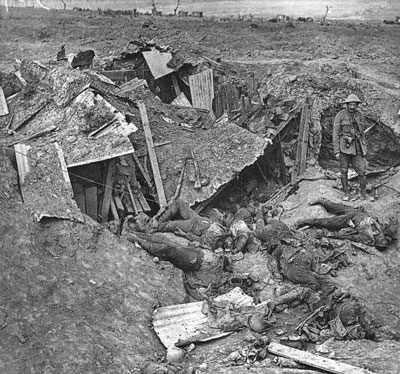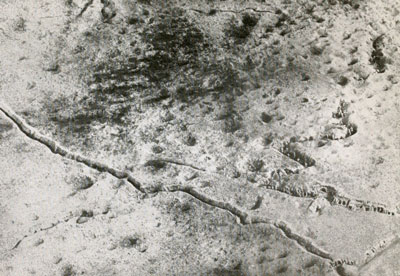
WWII: Maginot Line | Normandy | V-Weapon Sites | Arnhem
Further afield: Crete
| Home Tracing Military Ancestors Travel Advice CWGC Cemeteries Iron Harvest News Book Reviews Glossary Links Contact Me The Somme:
 
|
The Battle for the WoodsMeanwhile to the south and east of the Albert-Bapaume road, Fourth Army became bogged down in a series of struggles. These were centred around the capture of High Wood and Delville Wood on slightly higher ground and the nearby villages of Ginchy and Guillemont to try and secure good starting positions for a further concerted advance alongside the French. The tangle of undergrowth and blasted trees combined with the loosely held German defences here presented the British with a unique set of problems. Aerial observation was difficult, infantry advances became disorganised amongst the broken ground and heavy artillery fire exacerbated the situation. Also, following the Night Attack, German defences had evolved and the front line was now fairly lightly held to avoid casualties during the bombardment preceding a British attack. Troops were held back for use in counter-attacking actions. Despite reaching Longueval village and Delville Wood during the Night Attack, German positions in the northern part of the village and wood held out and it was not for another six weeks that the wood was secured. During the intervening period no less than six British divisions and the South African Brigade were thrown into the wood to attempt its capture and also to fend of relentless German counterattacks. In the heaviest fighting between the 15th and 20th July, the South African Brigade supported by the 9th Scottish Division sustained massive casualties as they tried to hold the wood and the southern portion of Longueval village against determined German counter-attacks backed by heavy artillery fire. By the time they were relieved the 9th Division had lost 7,500 men and the South African Brigade nearly 2,400, over 75% of their number when commencing the action. In fact, it was not until 3rd September that the wood was finally consolidated and then largely because German positions on either flank had been taken. By then the 2nd, 3rd, 5th, 14th (Light), 17th (Northern) and 24th Divisions had all experienced the horrors of fighting in "Devil's" Wood. Yet the Germans had also suffered significant casualties. With the woods acting as a focus of action, British artillery targeted them. The German 26th Regiment that fought against the South Africans took 90% casualties. Delville Wood had become a graveyard for both sides.
High Wood had also been reached in the Night Attack but, as with Delville Wood, it proved very difficult to take. On raised ground guarding the Longueval to Martinpuich road, the wood provided the Germans with excellent observation of the surrounding countryside. After the failure of the cavalry charge on 14th July, an attack by 100th Brigade took the south-west corner of the wood but at a cost of 1,300 casualties. The battle raged throughout August with the British even using mines in early September to try and dislodge the German defenders. Eventually the 47th (London) Division took the wood during the general advance of 15th September, albeit with further heavy losses. Guillemont and the neighbouring village of Ginchy lay at the south-eastern end of the ridge that connected Delville Wood, High Wood and Pozières-Thiepval. Haig was particularly worried about potential counter-attacks from this area into Caterpillar Valley which was crowded with gun batteries. Guillemont's capture would enable the British to straighten their line and make a further concerted attack alongside the French to their right. But the approaches to the village were all across open ground – dominated by enemy machine guns and German artillery. An initial attack out of Trônes Wood by the 30th Division with the aim of taking Guillemont and Waterlot Farm, which lay between the village and Delville Wood, ended in failure in the face of uncut wire and German counter-attacks. A week later the 30th Division attacked again. This time the 2nd Royal Scots entered the village itself and took some prisoners, but again German counter-attacks from south of Guillemont halted the advance. 2nd Royal Scots became isolated in the village and, following hand-to-hand fighting, were wiped out – losing 17 officers and 633 men. Better artillery preparations preceded further attacks by the 2nd, 3rd, 24th and 55th Divisions on the 8th, 9th, 12th, and 16th August. But again the story was the same – machine guns scythed through the waves of infantry and any troops entering the village were immediately counter-attacked by Germans who had been lying in wait in deep inter-connected bunkers and tunnels. Casualties were horrendous – in just a few days the 55th Division lost 4,100 men. It was becoming clear to everyone that the British artillery was unable to pinpoint and destroy the machine gun nests that were causing such havoc and the rubble of Guillemont village was acting as a perfect haven for them. At last, on 18th August, a joint attack with General Fayolle's French XX Corps in support on the right was organised. The heaviest bombardment to date followed by a creeping barrage allowed British troops to capture the higher ground to the south of Guillemont and make serious inroads into the northern half of the village. But despite further attacks by the 35th Division on 21st the Germans incredibly remained in control of the village. German defensive artillery fire was now becoming very destructive as the British infantry were terribly exposed on the open slopes in front of Guillemont. Water too was in short supply as nothing could be got forward through the curtain of fire from both sides. On 24th August the French I Corps pushed the line forward, within assaulting distance of Falfemont Farm, the key defensive position to the south of Guillemont but, just as the final battle for the village looked imminent, heavy rain moved across the Somme reducing trenches to mud. Despite coming under increasing pressure from Haig to capture Guillemont, Ginchy and Falfemont Farm with the utmost speed, Rawlinson had no choice other than to postpone any further advance. It was not until 3rd September that the ground had dried sufficiently to contemplate further operations in this sector. The final act was played out on the 3rd and 4th September. Three divisions of XIV Corps were involved – the 7th attacking towards Ginchy from the direction of Delville Wood, the 5th Division with its focus being Falfemont Farm and the 20th (Light) Division facing Guillemont village itself. This time the artillery laid on a crushing rolling barrage moving 25 yards every minute. This finally knocked the life out of the German defence and 20th Division swept into the village, capturing over 700 prisoners. To the south, whilst being initially checked by flanking fire from positions not yet engaged by the French, the 5th Division made good progress with Falfemont Farm falling on 4th September to the 1st Bedfords. Outflanked, Ginchy fell to the 7th Division by nightfall on the 3rd. Three Victoria Crosses were awarded to men of the 20th Division. Even by the standards of the Somme fighting, the battle for Guillemont was one of the severest tests for the British Army and, sadly, one of the least remembered. 5th Division had lost over 4,200 men in the battle and 20th (Light) Division a further 3,000 men. Guillemont had ceased to exist – long since reduced to rubble, the incessant artillery mincing machine had left nothing but a muddy hollow where the village had once been. Yet for the Germans too it had become one of the worst killing grounds of the war. And soon a new and terrible weapon was to be revealed to them.
|

